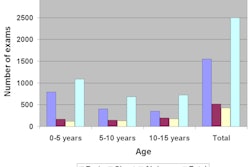Researchers in Spain are recommending that physicians use the upper third of the humeral head as the optimal injection site for anterior MR arthrography of the shoulder.
The researchers also concluded that it is "a simple, rapid procedure that is well tolerated by patients and reduces the radiation dose administered."
The lead author is Dr. María Redondo from the department of radiology at Virgen de la Arrixaca University Hospital in Murcia. Study details are published in the American Journal of Roentgenology (November 2008, Vol. 191:5, pp. 1-4).
The best place for injection for shoulder arthrography has been debated among physicians, who commonly use one of three options -- the upper third of the medial part of the humeral head, the lower third of the medial part of the humeral head, or the area between the middle and lower thirds of the glenohumeral joint.
The retrospective study analyzed 78 consecutive MR arthrography patients from February 2005 to September 2007. The mean age of the 50 men and 28 women was 45.2 years, ranging from 15 to 75 years. In the study sample, 43 patients exhibited glenohumeral instability, 20 patients had chronic shoulder pain, 14 patients were suspected of having a tear in the rotator cuff, and one patient had adhesive capsulitis.
Patient criteria
Patients with a fracture in the shoulder area, anticoagulant treatment or coagulation problems, a history of allergic reaction to contrast agents, and articular infection or inflammation were excluded from the study.
The MR imaging procedure had patients in a supine position on a fluoroscopy table (Siregraph CF, Siemens Healthcare, Erlangen, Germany) with the shoulder in external rotation. If a patient experienced discomfort, his or her shoulder was placed in a neutral rotation.
The intra-articular contrast material was injected following the arthrography technique, using a marker plate with radiopaque coordinates to select the injection site without the need for fluoroscopic guidance.
The study noted that physicians used a 22-gauge, 1.5-inch (4-mm) spinal needle for injections to the upper third and lower third of the medial part of the humeral head, and a 22-gauge, 3.5-inch (88-mm) spinal needle for injections to the glenohumeral space.
Researchers recorded whether a patient's shoulder was in an external rotation (50 cases, 64%) or in a neutral rotation (28 cases, 36%), whether the needle had to be repositioned to inject into the joint, and whether any complications arose within 30 minutes of the procedure being performed. In two of the 78 patients, physicians had to reposition the needle for injections in the glenohumeral space, because the contrast material had been injected into extracapsular soft tissue.
No dilemmas
In their evaluation of the MRI findings among all 78 patients, researchers concluded that "no diagnostic dilemmas based on the site of injection arose, because no qualitative differences were observed."
Researchers found no distortion of the anterosuperior labrum, superior glenohumeral ligament, or coracohumeral ligament in the patients when the injection site was in the space corresponding to the rotator cuff interval.
"For MR arthrography examinations of the shoulder, contrast injection into the upper third of the humeral head is best tolerated by patients," the authors wrote. "In addition, the time required by the radiologist and patient exposure to radiation are both reduced. Injection in this site is also simpler and more rapid to perform in comparison with the other two sites analyzed in this study."
By Wayne Forrest
AuntMinnie.com staff writer
October 20, 2008
Related Reading
Making the most of MRI to assess the rotator cuff pre- and postinjury, November 9, 2007
MRI keeps pace with rapidly evolving musculoskeletal systems of young athletes, May 20, 2007
MR arthrography depicts tears, instability in triangular fibrocartilage complex, January 19, 2007
MR arthrography typifies cam and pincer FAI for intracapsular hip surgery, August 22, 2006
MR arthrography proves superior to standard MR in labral tears, January 24, 2006
Copyright © 2008 AuntMinnie.com

















